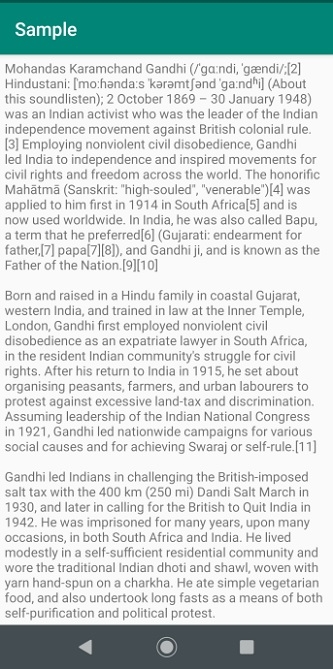
 Data Structure
Data Structure Networking
Networking RDBMS
RDBMS Operating System
Operating System Java
Java MS Excel
MS Excel iOS
iOS HTML
HTML CSS
CSS Android
Android Python
Python C Programming
C Programming C++
C++ C#
C# MongoDB
MongoDB MySQL
MySQL Javascript
Javascript PHP
PHP
- Selected Reading
- UPSC IAS Exams Notes
- Developer's Best Practices
- Questions and Answers
- Effective Resume Writing
- HR Interview Questions
- Computer Glossary
- Who is Who
How to create a scrollable textView Android app?
This example demonstrates how do I create a scrollable textView in android app.
Step 1 − Create a new project in Android Studio, go to File ⇒ New Project and fill all required details to create a new project.
Step 2 − Add the following code to res/layout/activity_main.xml.
<?xml version="1.0" encoding="utf-8"?> <RelativeLayout xmlns:android="http://schemas.android.com/apk/res/android" xmlns:tools="http://schemas.android.com/tools" android:id="@+id/activity_main" android:layout_width="match_parent" android:layout_height="match_parent" android:padding="5dp" tools:context=".MainActivity"> <TextView android:id="@+id/textView" android:layout_width="wrap_content" android:layout_height="match_parent" android:scrollbars="vertical" /> </RelativeLayout>
Step 3 − Add the following code to src/MainActivity.java
package app.com.sample;
import android.support.v7.app.AppCompatActivity;
import android.os.Bundle;
import android.text.method.ScrollingMovementMethod;
import android.widget.TextView;
public class MainActivity extends AppCompatActivity {
@Override
protected void onCreate(Bundle savedInstanceState) {
super.onCreate(savedInstanceState);
setContentView(R.layout.activity_main);
TextView textView = (TextView) findViewById(R.id.textView);
String para = "Mohandas Karamchand Gandhi (/????ndi, ??ændi/;[2] Hindustani: [?mo???nda?s ?k?r?mt??nd ??a?nd?i] (About this soundlisten);
2 October 1869 – 30 January 1948) was an Indian activist who was the leader of the Indian independence movement against British colonial rule.[3]
Employing nonviolent civil disobedience, Gandhi led India to independence and inspired movements for civil rights and freedom across the world.
The honorific Mah?tm? (Sanskrit: \"high-souled\", \"venerable\")[4] was applied to him first in 1914 in South Africa[5] and is now used worldwide.
In India, he was also called Bapu, a term that he preferred[6] (Gujarati: endearment for father,[7] papa[7][8]), and Gandhi ji, and is known as the Father of the
Nation.[9][10]
" + "
" + "Born and raised in a Hindu family in coastal Gujarat, western India, and trained in law at the Inner Temple, London, Gandhi first
employed nonviolent civil disobedience as an expatriate lawyer in South Africa, in the resident Indian community's struggle for civil rights. After his return
to India in 1915, he set about organising peasants, farmers, and urban labourers to protest against excessive land-tax and discrimination.
Assuming leadership of the Indian National Congress in 1921, Gandhi led nationwide campaigns for various social causes and for achieving Swaraj or
self-rule.[11]
" + "
" + "Gandhi led Indians in challenging the British-imposed salt tax with the 400 km (250 mi) Dandi Salt March in 1930, and
later in calling for the British to Quit India in 1942. He was imprisoned for many years, upon many occasions, in both South Africa and India.
He lived modestly in a self-sufficient residential community and wore the traditional Indian dhoti
and shawl, woven with yarn hand-spun on a charkha. He ate simple vegetarian food, and also undertook long fasts as a means of both
self-purification and political protest.
" + "
" + "Gandhi's vision of an independent India based on religious pluralism was challenged in
the early 1940s by a new Muslim nationalism which was demanding a separate Muslim homeland carved out of India.[12] In August 1947, Britain
granted independence, but the British Indian Empire[12] was partitioned into two dominions, a Hindu-majority India and Muslim-majority Pakistan.[13]
As many displaced Hindus, Muslims, and Sikhs made their way to their new lands, religious violence broke out, especially in the Punjab and Bengal.
Eschewing the official celebration of independence in Delhi, Gandhi visited the affected areas, attempting to provide solace. In the months following,
he undertook several fasts unto death to stop religious violence. The last of these, undertaken on 12 January 1948 when he was 78,[14] also had
the indirect goal of pressuring India to pay out some cash assets owed to Pakistan.[14] Some Indians thought Gandhi was too accommodating.[14][15]
Among them was Nathuram Godse, a Hindu nationalist, who assassinated Gandhi on 30 January 1948 by firing three bullets into his chest.[15";
textView.setText(para);
textView.setMovementMethod(newScrollingMovementMethod());
}
Step 4 − Add the following code to androidManifest.xml
<?xml version="1.0" encoding="utf-8"?> <manifest xmlns:android="http://schemas.android.com/apk/res/android" package="app.com.sample"> <application android:allowBackup="true" android:icon="@mipmap/ic_launcher" android:label="@string/app_name" android:roundIcon="@mipmap/ic_launcher_round" android:supportsRtl="true" android:theme="@style/AppTheme"> <activity android:name=".MainActivity"> <intent-filter> <action android:name="android.intent.action.MAIN" /> <category android:name="android.intent.category.LAUNCHER" /> </intent-filter> </activity> </application> </manifest>
Let's try to run your application. I assume you have connected your actual Android Mobile device with your computer. To run the app from android studio, open one of your project's activity files and click Run ![]() icon from the toolbar. Select your mobile device as an option and then check your mobile device which will display your default screen −
icon from the toolbar. Select your mobile device as an option and then check your mobile device which will display your default screen −

Click here to download the project code.

